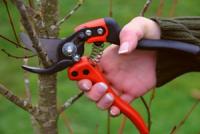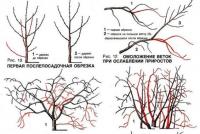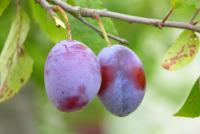Mountain ash rowan Sam® Gorobinnik Gorobinolisty Sem® Sorbaria sorbifolia Sem®
Landing: No special requirements. All plants acquired in the Proxima nursery are provided with modern long-lasting fertilizers and can be sold in your garden center without additional fertilizing for a whole year. It is better to buy seedlings in a plastic container with prolonged fertilizers, so the plant is not subjected to digging with the inevitable damage to the root system and after planting it is guaranteed to take root.
All plants purchased in the nursery PROXIMA, provided with prolonged fertilizers with the latest formulas of the best European manufacturers and can be sold in your garden center without additional dressing for a whole year. But the greatest advantage of buying plants in a pot is that they can be planted without buying additional fertilizers, from March to December - even on the hottest days of summer.
Care: In order to avoid the formation of thickets and a large number of root suckers, limiting the root system is recommended to maintain the planting line and maintain the compactness of the crown. It is also necessary to remove the flowering inflorescences to maintain the decorativeness of the crown. Early spring should be pruned to remove old and weak branches.
Diseases and pests: Untreated plants can be affected by anthracnose (leaf spot), powdery mildew, rot, rust. To protect the plant from diseases and fungal infections, it is necessary to treat plants with fungicides (Scor, Switch, Maxim, Ordan, Horus, Quadrice, Radomil Gold, etc.). In hot, dry weather, spider mites, aphids, can be attacked. In the spring and again in the summer they carry out preventive spraying with insecticides (Aktara, Engio, Aktellik, Match).
Of course, it is better to have a “diagnosis” put by a specialist. But, as a rule, a modern gardener with the help of the Internet can independently identify the enemy and choose the right methods and means of protecting the plant. It is better to carry out preventive treatments once a month than to treat them when the pest multiplies and “eats” the plant. An example is the war of Ukrainian gardeners with Colorado beetles, who, like their human “wadded” namesakes - Kremlin occupiers of “Colorado” - are gluttonous and climb into other people's gardens. The first and second must be destroyed before spreading over large areas.
Ground pests: Untreated plant can damage scoop, bark beetle, spider mite. In comparison with the gluttonous May larva larva, the remaining pests on a well-kept plant are rare. Over the past 10 years, Khrushchev, especially on humus-rich, weed-free soils, has become the most dangerous pest. garden plants Of Ukraine. One grub larva can nibble in 1 day root system young 10-30cm sapling, completely destroying it. Since mid-April, having seen the first flying beetle, we URGENTLY process the crown with any of the many preparations based on Imidacloprid, for example Prestige (Bayer), Antikhrushch, and part of the solution must necessarily fall on the trunk (10 cm above the ground) and root collar and not spill to the side . Such treatments are repeated every 40-50 days of the growing season. We spill into the soil according to the instructions, Aktar is also effective. Processing on the crown and pouring on the root collar into the soil from the end of April to September 1 every 40-60 days.
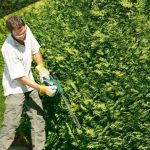
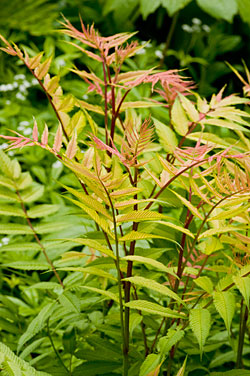
In order for the garden to be beautiful from early spring to leaf fall, rely on decorative leafy plants. Such, for example, as a mountain ash бин бин. This variety was bred in Europe relatively recently. It is also unpretentious, as well as its natural prototype, at the same time it favorably differs from dikoros in the smaller sizes, and the main thing - unusually bright and various coloring of young leaves.
Leaves in mountain ash - and therefore the mountain ash.
The ashberry is a ryabinolistnyy - a native of Siberia, has long been bred in the gardens of the Russians as ornamental shrubs. It is attractive with graceful, odd-pinnate leaves, small white flowers, collected in compact pyramidal panicles, long-term flowering. Actively expanding with the help of offspring, the mountain-ash forms picturesque thickets about the height of a man.
The name of the Fieldfare was due to the similarity of its leaves with the leaves of mountain ash. The leaves are really their structure resemble rowan, but it is much more attractive than the latter. They are single-pinnate, consist of 9-13 pairs, densely perched on the petiole of the lanceolate, with a thinly drawn top, finely serrated on the edge of the leaflets. In addition to the attractive addition, the special charm of the leaves gives a pleasant to the eye pressed parallel veining.
But especially good leaves of fieldfare in the spring. When blooming and the first time from a distance, they attract attention with unusual yellow-orange shades. By the middle of summer, the color flavor is lost, the leaves turn green, although they remain brighter than the general background. At the same time, young leaves, which the shrub continues to generate until August, are different in color from ordinary greenery.
Young and promising - named "Sam."
All these qualities, but in a much greater concentration, have the “Sam” variety that is gaining popularity among Russians. It is three times lower than the main species (maximum height 120-150 cm) and is more compact, gives fewer offspring, and its leaves are somewhat smaller. And most importantly, its young leaves are painted much brighter and more diverse than that of wild plants. It is the leaves, not flowers, that are Sam’s main decorative property. To describe them personally, epithets seem appropriate to me: openwork, carved, ornamental, colorful, bright. In their color spectrum there are not only yellow and orange tones, but also all shades of red - from light pink to magenta.
"Sam" blooms like the main species at the end of June, but not large, and the size of its inflorescences, in comparison with the wild species, is small. So bloom often passes almost unnoticed. This, by the way, is more dignity than a disadvantage, because species shrubs flowering inflorescences are no longer an ornament and require removal.
Especially valuable qualities are inherited "Sam" from the wild ancestor of frost resistance and unpretentiousness. It is undoubtedly interesting to both the ordinary amateur and professional landscapers, for whom it is so important not to lose face in front of the customer. "Sam" will not fail, will not lose its gloss at the most inopportune moment. Absolutely frost-resistant, “Sam” is very interesting for northerners. It should be noted that the leaves of “Sam” are not completely discolored, and although their brightness is slightly lost in June, it remains attractive.
So that you know.
Rod field soldier (Sorbaria)belonging to the family Rosaceae, has 10 shrub species, common in Asia, including in southern Siberia and the Far East. Mountain ashberry (S.sorbifolia) except the south of Siberia, it is found in China, Korea, and Japan. It grows as a medium-growth shrub about 2 m high (up to a maximum of 3 m) of a bush, with numerous straight, densely branching shoots. Leaves are single-pluminal, up to 25 cm long from 9-13 leaflets. By their addition, they resemble rowan, but only with a superficial glance. A shrub blossoms in June-July, small creamy-white flowers, collected in dense pyramidal panicles, up to 30 cm long, concentrated on the ends of the shoots. Flowering lasts about a month, in favorable conditions it is very abundant and impressive.
Planting and care.
Like all Samov бин s foot soldiers, it is moisture-loving, and it is not demanding of fertility. It grows well both in the open sun and in various penumbra variants. At the same time, the shrub reaches the best decorative conditions on wet and drained, organic-rich soils. On the contrary, the combination of dryness and sterility of the soil, peculiar to lean sandy loams, is the most unsuccessful for the mountain ash.
Location Open sun, slight or temporary partial shade.
The soil. Light or medium fertile loam of neutral or weakly acid reaction - pH = 6.5-7.0. A variation of the substrate can a mixture of sod land, humus and sand in an approximate ratio of 1: 1: 1 or 1: 2: 1.
When planting for shrubs dig holes shallow - enough 30-40 cm deep, but wide enough - up to 70-80 cm - taking into account its growth. When located on the slopes, tree trunks should be formed in the form of gentle funnels with a slope to the center of the bush, otherwise plants may suffer from a lack of moisture. Fieldfare well tolerated transplant. Shrub seedlings are well preserved when shipped by mail.
Care. The soil of the earthen coma of the shrub should be kept in a moderately humid state, and the base of the bush should be kept loose and free from weeds.
Fieldfare gratefully responds to the introduction of any kind of organic matter: humus, peat, compost. Digging of the trunk circle is not recommended, therefore fertilizers are shown to be applied superficially or under shallow embedding. The continuous thickets of the fieldfare force out the weeds, therefore weeding is necessary only at the beginning. Since the plant loves loose substrates, systematic mulching with peat, leaf humus and various types of composts is useful. It is advisable to perform the operation at least 2-3 times per season, in small doses, then the fertilizer will naturally assimilate. It is also recommended 1-2 times a year to sprinkle universal (NPK) mineral mixtures into the base of plants at a rate of no more than 20g / m 2.
Reproduction. The most simple rowfishes breed multiply bush or root suckers. Wild species can be easily propagated by seed. Green cutting is usually used for Sam and other varieties of mountain ash as the most productive and reliable method.
"Sam" in a private garden and in urban gardening.
On the one hand, the leaves of the fieldfare are reminiscent of the fronds of a fern, so the overgrown shrubs look very natural. On the other hand, it has almost a floral color. Because of this, “Sam” “eyes flare up”, both among those who love flower beds and those who support landscape style. The shrub is particularly attractive in that the peak of its ornamentalness comes at a time when the garden is just waking up from hibernation. At this time, the brightness, especially in the middle tier of gardening, is in absolute deficit. In addition to the decorative advantages, the Fieldfare is valuable because it is resistant to pests and diseases, and never loses its decorativeness.
A separate bush. Consider that the bush will grow over time and after 6-8 years it can “scatter” to the side by 70–80 cm. "Sam" looks good in mixed compositions based on contrasting combinations of color and shape. A single plant can be made the center of a small composition if you surround it with a carpet of perennial ground cover. In this capacity, suitable zhivuchki, lulznike monetchaty, kammelomki, mshanka, etc.
Group, array, curb. In essence, a group, that is, several Sam bushes planted next to each other can very soon turn into a solid array. Outwardly, it is very reminiscent of fern thickets. Both can be a wonderful element of yard gardening "in the highest category." Mountain arrays are appropriate as a tamper at the foot of wood groups, and such flowering shrubs like lilac and chubushnik.
Decorative leafy gardens. Compositions of plants, the main decoration of which are leaves, are good in that they do not require much labor and at the same time never lose their decorativeness. With such plots it is advisable to draw up the most important places of gardening. Next to "Sam" geyhery, hosts, thujas, junipers, badany look good ...
In all cases, the crown of an adult bush is advisable with a haircut to give a more compact form. Borders and arrays look very non-standard and interesting, their tops are trimmed at the knee height. It is enough to cut the bushes three times per season: the first time after the end of the first wave of growth - at the end of May, the second - in the middle of summer, and the last time at the end of September.
Fieldfare well tolerates the urban environment and is very desirable in all private and public landscaping. Owners of roadside food outlets, cafes, gas stations, and motels interested in spectacular and low-cost landscaping will surely appreciate it. The use of fieldfirth is justified in the form of continuous thickets in those places that can be given to the shrub entirely, because they have natural barriers for its growth: islands of car lashes, windows in paving, etc. Its informal borders bordering on the edges of a group of tall shrubs and trees are unusually good.
In addition, it has a very pronounced decorative showiness. was widely spread due to its beauty and unpretentiousness. However, care for him has its own characteristics.
Description
Mountain ash is originally from Asia (Korea, Japan, the Far East, north of China, Mongolia). In the wild, it grows in floodplains, ravines and along rivers. The shrub got its name for the similarity of its leaves with leaves. They are also lanceolate, pinnate with paired veins. Did you know?The Latin name of the plant (Sorbaria sorbifolia) also reflects its similarity to: mountain ash in Latin - sorbus. The plant has many upright shoots 1.5 cm thick and reaches a height of 2.5-3 meters. begins in early spring and continues until the end of October. Did you know?When the leaves of the forest soldier just bloom, they have a pink-orange color, become emerald green in the middle of the season, and, starting in September, turn yellow-red.
The shrub blooms every year with milky-white buds in the form of panicles up to 25 cm long. The diameter of the flowers is about 10-12 mm, while the length of the stamens is much larger than the length of the petals, which creates an interesting decorative effect. Flowering lasts from two to four weeks. After completion of flowering panicle pruned, as the fruits of decorative values do not have. 
Site selection and soil preparation
This shrub is unpretentious, so the gardener is almost unlimited in choosing a place for his planting: both sunny and shaded places will fit (for example, under the canopy of trees), and he is not particularly picky about quality. The best option for planting is a fertile loam with soil acidity close to neutral (pH 6-7). Important! The only requirement is moisture: the plant does not tolerate drought.
Planting technology for the mountain ash
This plant multiplies well as stiffened, root shoots,. Cultivars by seeds multiply worse - it is better to get cuttings.
Landing time
Planting fieldfare should be in early spring. Additionally, insulate seedlings is not necessary. You should not be afraid that they will freeze in case of frosts: the homeland of this shrub is rather harsh, therefore the probability that it will take root is almost equal to 100%. 
Landing pattern
Before planting, you should carefully examine the seedlings and remove damaged, dry and weakened branches. The remaining shoots are short cut to 10-15 cm, leaving 2 to 4 buds on each branch. The pits are shallow, but wide (taking into account the growth of shrubs).
The depth of the pit should be about 30-40 cm, diameter - from 50 to 80 cm. The pit is filled with the substrate, which consists of sod land, humus and sand in a ratio of 1: 2: 1. Fall asleep in excess to form a mound. Top sapling put, sprinkle it with earth, abundantly and peat or bark.
Fieldfare can be planted in areas with a strong slope, but it is necessary to form a trunk circle so that water can linger in it. To do this, from the side of the slope dig a deeper funnel, making the bush a small terrace. 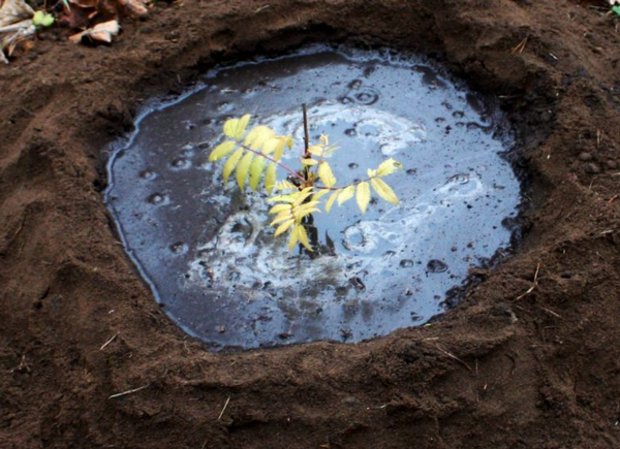
How to care for ornamental shrubs
As noted above, the fieldfare is unprincipled and does not require careful care, but he will thank for a small amount of attention, revealing his beauty to the full.
How to water the plant
The Fieldfare does not tolerate a long-term drought, but it is highly moisture resistant and easily withstands slight flooding. Therefore, it is better to overdo it than to be cautious and regret for a bush of water. Immediately after planting and the first year of watering is often and abundant.
With further care, root is enough 2-3 times a month (in hot, dry weather, it is worthwhile to make it more frequent). If the plant does not fall in direct sunlight (or after sunset, if the plant is in the sun), you can pour water and leaves - it loves increased humidity. 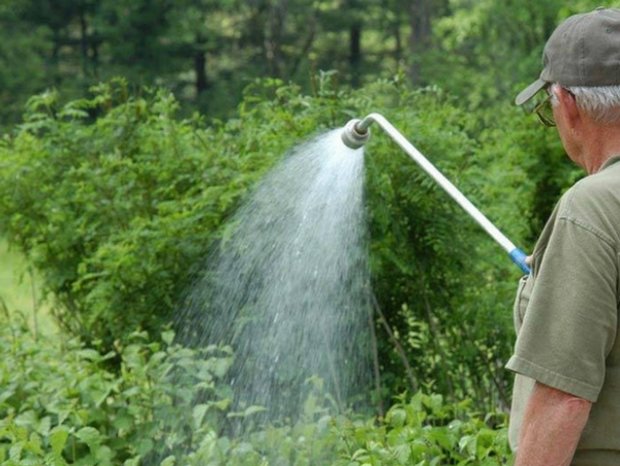
Weeding and Loosening
Deep weeding is not recommended for a grassland, as it has a developed non-deep root system. The first year of life you can help him fight, then he will cope on his own. To avoid drying out of the soil, it is worth several times a month after loosening the trunk circle to mulch it with peat or bark.
Top dressing and fertilizer
Since the shrub has a developed green mass, which is also updated during the season, it requires regular feeding. Can be limited
Shrub trimming
In the third year, it's time to prune. First of all, cut dry, broken, diseased and creeping branches on the ground. To shape, remove those branches that go beyond the limits of the projection. Forming shearing is carried out throughout the season.
When using a shrub as pruned it will have 3-4 times per season. In addition, it will be necessary to pay attention to the root growth, which tends to grow, and the fence can lose shape. 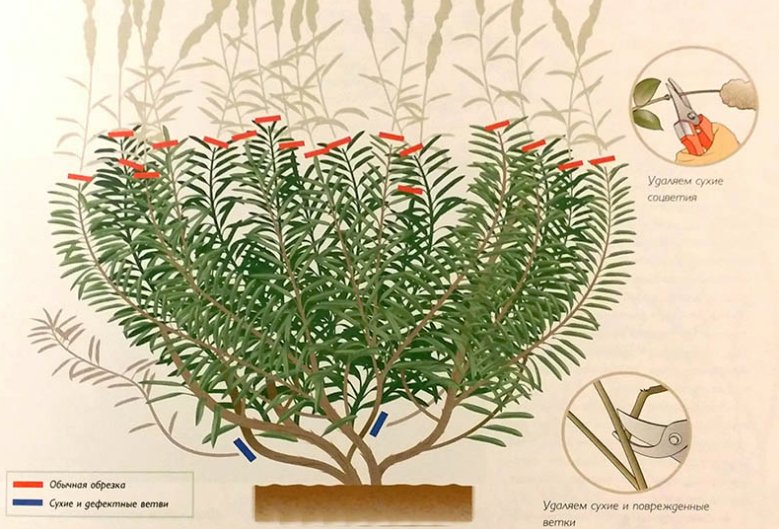
Preparing the snowy field for winter
This plant tolerates even extreme cold, so it does not need special insulation. In number unpretentious shrubs for the garden are: Fitoverma "or" Mitaka ". Sometimes the mountain soldier gets viral mosaic. Unfortunately, this disease is incurable, and the affected plant will have to be destroyed. 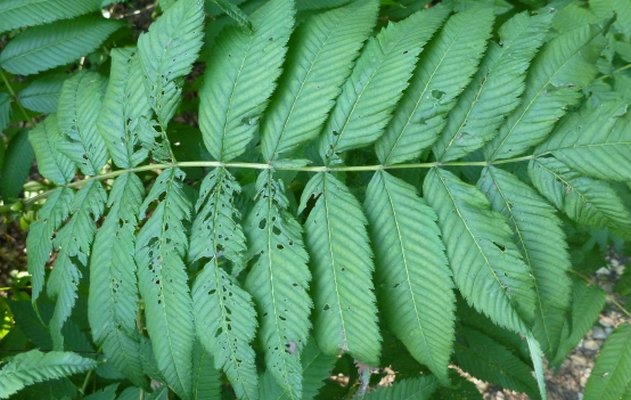
Mountain ash rowan in landscape design
Resistance to frost, unpretentiousness and resistance to allow extensive use of the grass-roots in park design. Use both single bushes, and group landings, form with its help live hedges and compositions with other plants. Among shrubs in landscape design Also popular:,.
However, it should be remembered that the forest soldier is prone to rapidly spreading root shoots, capturing vast spaces and displacing other plants. True, modern varieties (for example, "Sam") partially coped with this problem. 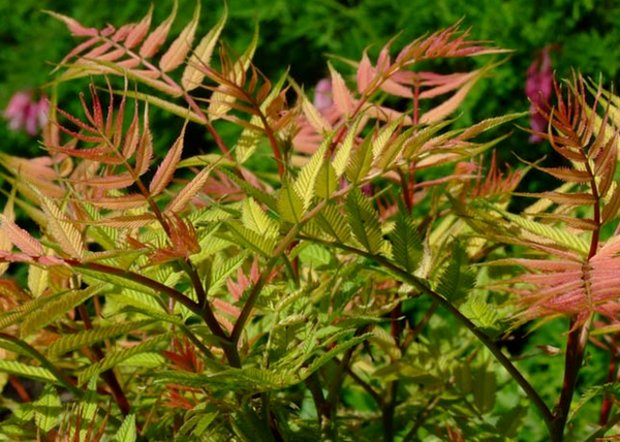 Did you know? The property of the mountain ash spreading the root system widely, giving it growth, is used to strengthen steep slopes and ravines. Landing grassfields on the banks of reservoirs, especially during flowering, look very impressive. Apply this shrub, not only in landscape gardening, but also for other applications. For example, they are planted dividing lanes on highways or islets in the pavement blind area.
Did you know? The property of the mountain ash spreading the root system widely, giving it growth, is used to strengthen steep slopes and ravines. Landing grassfields on the banks of reservoirs, especially during flowering, look very impressive. Apply this shrub, not only in landscape gardening, but also for other applications. For example, they are planted dividing lanes on highways or islets in the pavement blind area. 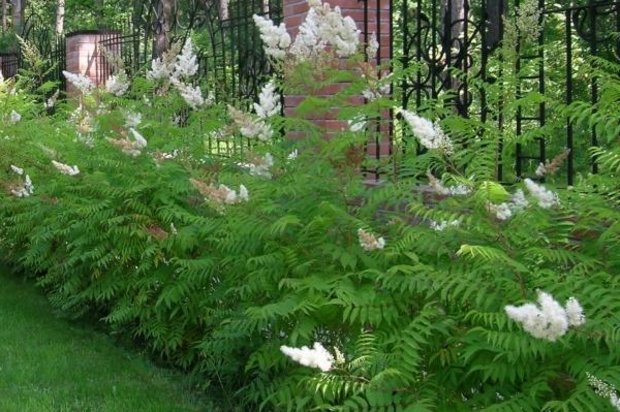 Mountain ashberry is a plant, the simplicity of planting and care for which has provided him the love of gardeners and landscape designers. This shrub will delight the eye from early spring to late autumn with the richness and unexpectedness of foliage colors, beauty and fragrance of flowers.
Mountain ashberry is a plant, the simplicity of planting and care for which has provided him the love of gardeners and landscape designers. This shrub will delight the eye from early spring to late autumn with the richness and unexpectedness of foliage colors, beauty and fragrance of flowers.
Was this article helpful?
Well no
Mountain ashberry belongs to the Rosaceae family. The leaves of the plant are similar to the leaves of mountain ash, so its Latin name comes from the word “sorbus” - mountain ash.
The genus of the mountain ash combines ten species, whose homeland is Asia.
The plant is planted for the improvement of the garden plots - it unfolds the leaves early and blooms profusely for a long time.
Shrub features
Mountain ash grows along river banks and on forest edges, forming dense thickets.
The plant grows mainly in Siberia, the Far East, Mongolia, China, Korea and Japan. Shrub reaches a height of two meters, has brownish-gray shoots.
The leaves, unlike mountain ash, have pointed edges and a pointed top.
In the spring, during the blooming of leaves, an openwork crown of a pinkish-orange color is formed, in the summer the leaves become light green, and in the fall a yellowish-red hue.
White-yellow odorous flowers form large inflorescences in the form of a conical panicle. The stamens are twice as long as the petals themselves, because of this, the inflorescence looks very nice during the period of blooming, and it feels fluffy and soft to the touch.
Shrub blooms from June to August. Two to three - summer shrub blooms every year. Fruits are not used for decorative purposes, so fall panicles are cut in the fall.
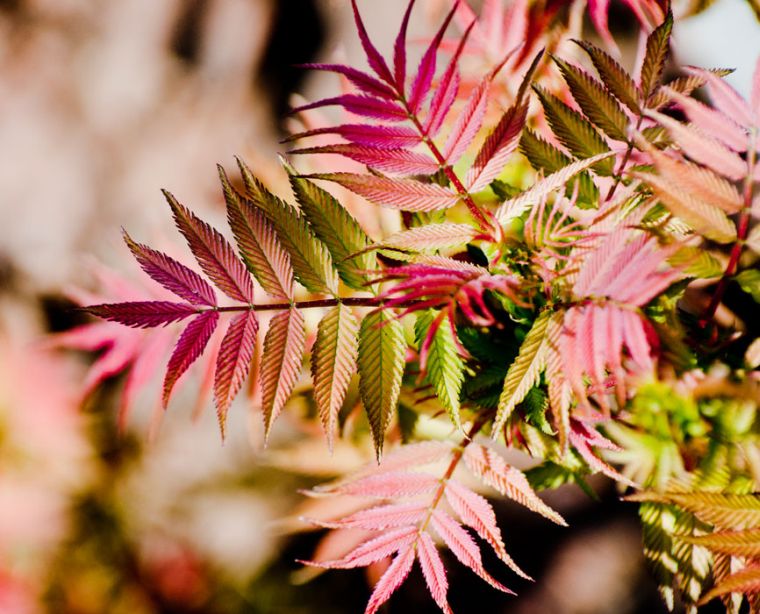
The ashberry ryabinolistny sam is widely used in landscape design
It is resistant to frost, it takes root well in any soil, however, a moderately moist soil is desirable. Due to lack of water it can suffer greatly: the bushes will grow poorly, become short, and the leaves will lose their decorative effect.
The plant can grow in the shade, grows well under the canopy of trees. Under favorable conditions and proper care mountain ash grows fairly quickly, tolerates transplant.
In general, it is beautiful and durable ornamental plant. Recommended for planting single and group copies, looks very interesting along the shores and in. With regular care and shearing forms thick fences.
The plant has a developed root system and therefore is often planted in order to fix the soil on the slopes.
Why do I need a brush cutter at the dacha? What types of tools are, what are the pros and cons of each. - The main parameters to which attention should be paid.
The handsome meter delphinium: landing and caring for it requires. Methods of reproduction and pest and disease control.
So, brief characteristics:
- soil: undemanding;
- illumination: sun, partial shade;
- soil moisture: does not tolerate drought;
- frost resistance: high;
- reproduction: cuttings, division, undergrowth;
- color: from light green to red-brown color;
- application: group planting, hedge;
- seasonal decorativeness: the entire growing season - foliage, July - whitish flowers in large inflorescences.
How does the mountain ash grow:
Main species and varieties
The most popular are the following varieties of fieldfare:
- Felt. Homeland - East Asia. It grows mainly on the slopes of the mountains. Shrub reaches a height of up to six meters. This type of grassfly does not bloom. Poor tolerates cold. For decorative purposes almost never used.
- Tree. Homeland - East Asia. Shrub reaches 6 meters in height. Blooming view, flowering begins in July and ends in August. It grows rather slowly. Frost-resistant
- . It grows in the mountains in the Alpine countryside, on rocky slopes, in the Far East and in Eastern Siberia. Small in size, can be used for decorative purposes. Young shoots are bare, brown in color. Old - with flaking bark. The leaves are large, up to 15 cm in length. The color of the leaves is dark green, the flowers are white or creamy white. It is easily propagated by seeds and root suckers. It is an early plant. The only negative - the fragility of the trunks. It tolerates pruning, recommended for planting in park areas.
- Actually. It is found in Siberia, China, Japan, Korea. It grows at the bottom of the slopes and in the floodplains of rivers. Shrub height - up to two meters. Shoots upright, spreading crown. Young trunks green, old - grayish-brown. The leaves are large, first pinkish, then light green. In autumn, the foliage becomes yellow or dark red. The flowers are white. Frost-resistant Easily tolerates transplant and haircut. Decorative in the period of mass flowering.
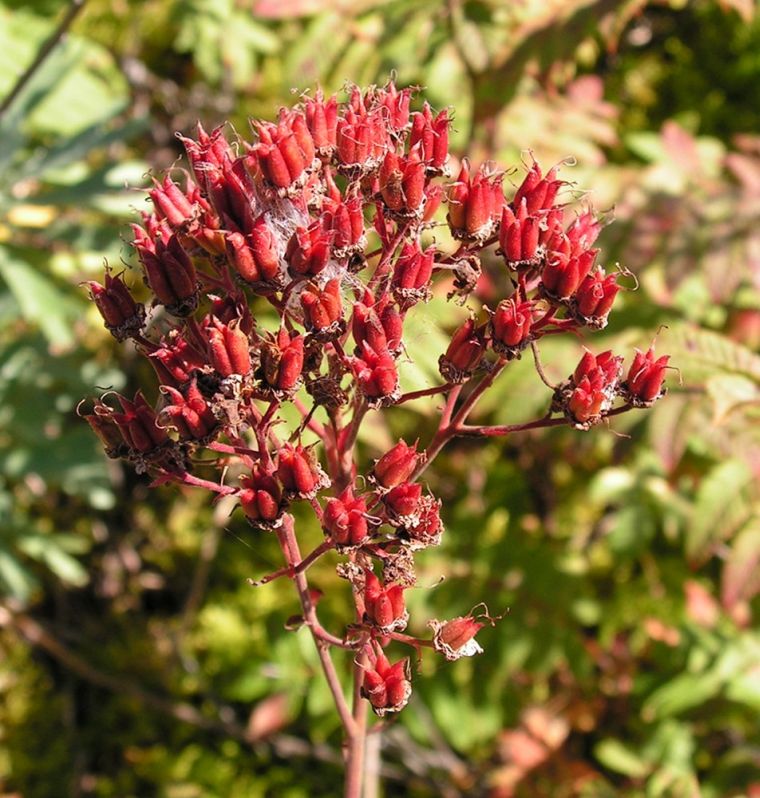
Pallas Fieldfare
Choosing a place for planting and soil preparation
Mountain ash is unpretentious in terms of selection of soil for planting.
The shrub grows well in the sun and in dark places. The best decorative effect is ensured when the soil is moist, well drained and rich in organic matter.
The worst combination for a fieldfare is dryness and poverty of the soil.
The best place for landing is a sunny plot with temporary penumbra. The soil can be an average neutral fertile loam (pH - 6.5-7). A mixture of sod, humus and sand in a ratio of 1: 1: 1 can act as a substrate.
When and how to plant?
Fieldfare plant in the spring. Shoots can be planted in early spring, as the shrub tolerates cold well. It is not necessary to prepare seedlings in advance. The plant is able to survive in harsh conditions, so worry about whether it will take root or not is not necessary.
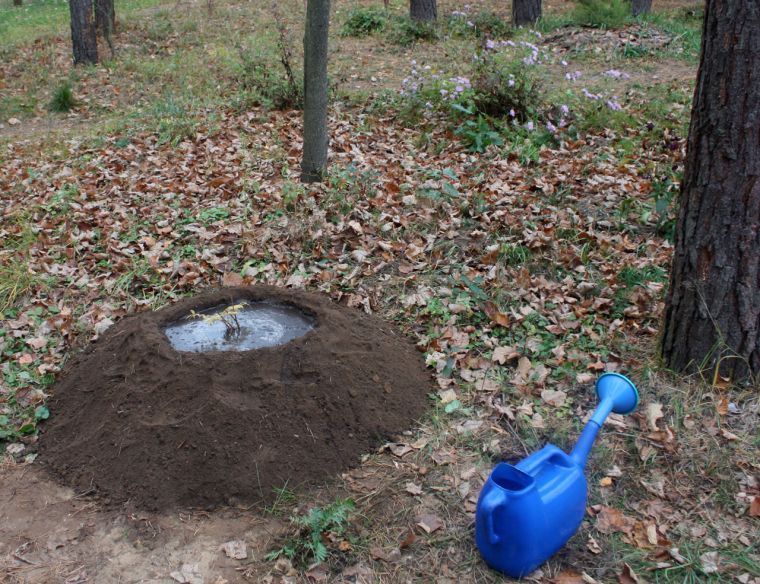
Planting the plant in the hole
For planting pull out shallow pits (up to 30-40 cm in depth). The width of the dimples is focused on the growth of the shrub, so the best option is up to 80 cm.
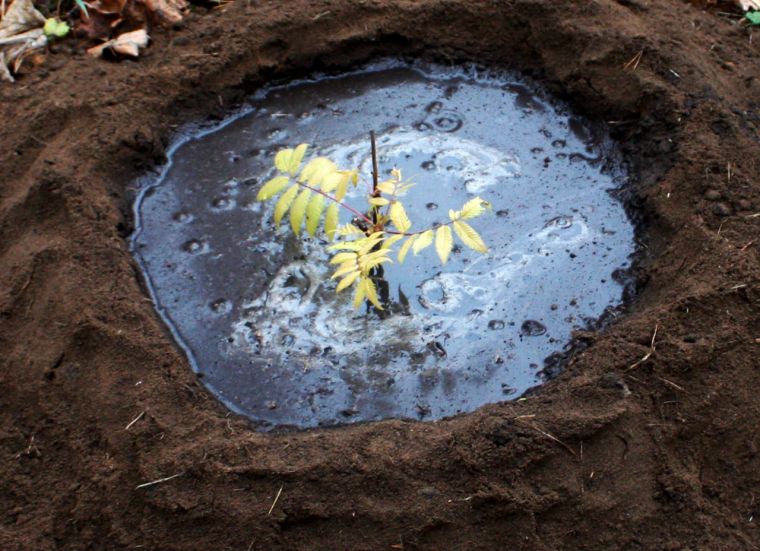
When landing on the slopes, tree trunks are formed in the form of gentle funnels with an inclination to the center of the shrub, otherwise the shrub will suffer from a lack of moisture.
Care: fertilizer, watering, pruning
The soil around the shrub needs to be maintained in a moderately moist and loose state. Next to the plant should not be weeds.
Fieldfare responds well to any type of organic matter: humus, peat, compost.
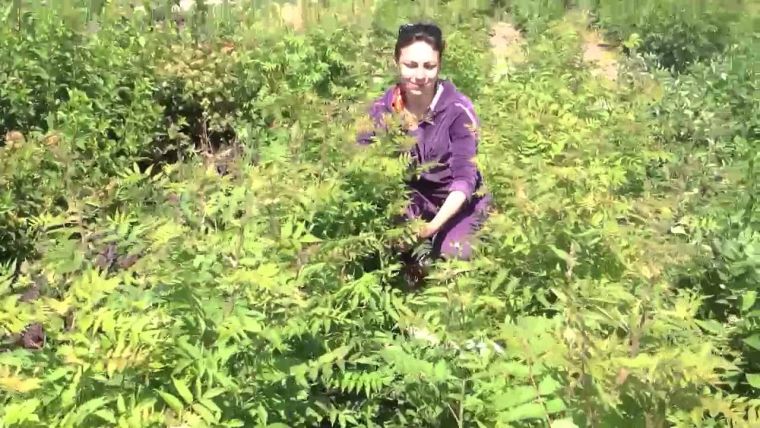
But if you want a hedge to be no more than 1 m, then every year in the spring you will spend forming a trimming bush. It will not affect the flowering bush, because flowers appear on the current year increment.
Cut need only faded inflorescences. This can be done in early spring: cut off the old inflorescence to the largest bud.
By trimming the shrub, you can adjust the height and width of the plant, shortening the shoots to the desired length.
Preparing for the winter
No special preparation for winter is required, as the shrub tolerates frost well.
Breeding methods
Mountain ashberry breeds by dividing the bush or root suckers.
But the most productive and reliable option is grafting. With seeds, this type of plant multiplies with great difficulty.
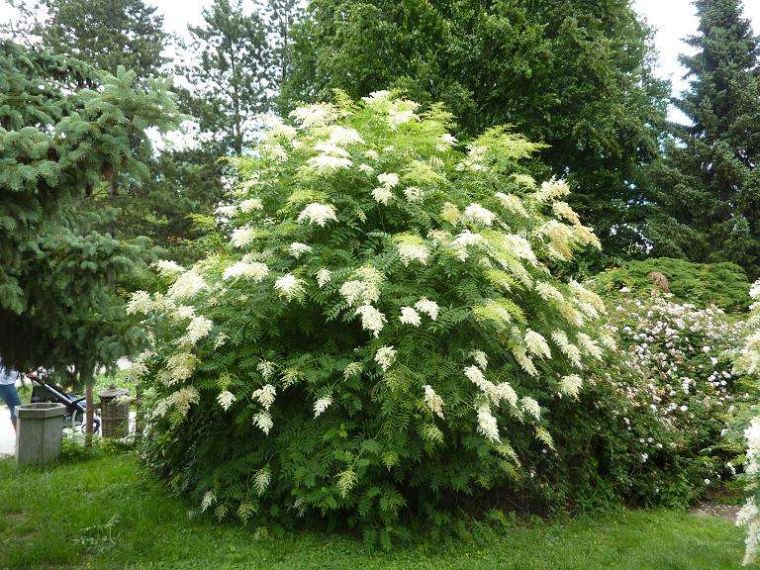
Aphids - the main pest
The plant is resistant to diseases and pests. The main harm to young shoots can cause green aphids, feeding on the sap of the plant. This can cause the leaves to curl and their ends to dry.
A Putinite mite can settle on the reverse side of the sheet. They fight pests with phytoverm solutions (30 ml of the composition for ten liters of water) or mitac (about 20-30 ml of the substance for ten liters of water).
Leaves are processed twice. For aphids, garlic extracts are good, onions and dandelion (1 to 5).
If a plant is damaged by a viral mosaic, yellowish-white spots are formed on the leaves. This disease is not treated, therefore, with a strong defeat, the diseased plant is destroyed.
Medicinal properties
Fieldfare is widely used for medicinal purposes. The leaves and flowers of the plant contain phenylethylamine, coumarins and flavonoids (astragalin, hyperoside, quercetin, trifolin).
The plant is applied in traditional medicine as an antirheumatic drug. Water infusions are made of flowers, with decoctions flowering shrubs take baths. Broth of a footberry is applied at internal and uterine bleedings.
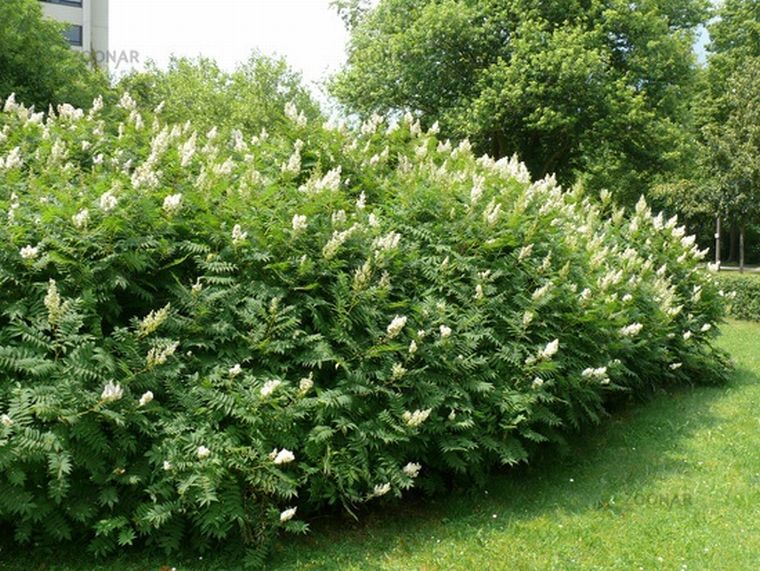
Plant roots are used for diarrhea, tuberculosis. The bark and leaves are used for gynecological and gastrointestinal diseases, as well as antihelminthic. Herbal tea from the bleached panicles can be used for gargling with sore throat.
The ashberry is a ryabinolistny - unpretentious in the care, but very beautiful ornamental plant. Shrubs look spectacular in group plantings and hedges.
The plant does not require any special preparation for winter, and during the growing season it is sufficient to remove the weeds, ensure regular watering and periodically feed.
Mountain ashberry - a native of Siberia, has long been bred in the gardens of the Russians as an ornamental shrub. It is attractive with graceful, odd-pinnate leaves, small white flowers, collected in compact pyramidal panicles, long-term flowering. Actively expanding with the help of offspring, the mountain-ash forms picturesque thickets about the height of a man.
The name of the Fieldfare was due to the similarity of its leaves with the leaves of mountain ash. The leaves are really their structure resemble rowan, but it is much more attractive than the latter. They are single-pinnate, consist of 9-13 pairs, densely perched on the petiole of the lanceolate, with a thinly drawn top, finely serrated on the edge of the leaflets. In addition to the attractive addition, the special charm of the leaves gives a pleasant to the eye pressed parallel veining.
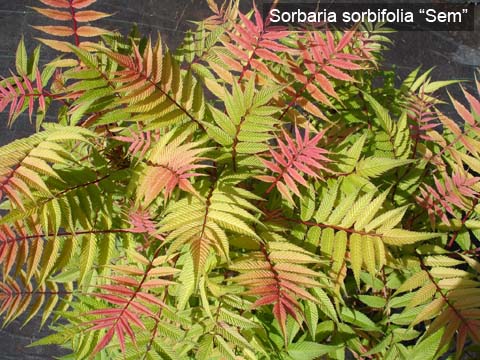
But especially good leaves of fieldfare in the spring. When blooming and the first time from a distance, they attract attention with unusual yellow-orange shades. By the middle of summer, the color flavor is lost, the leaves turn green, although they remain brighter than the general background. At the same time, young leaves, which the shrub continues to generate until August, are different in color from ordinary greenery.
Young and promising - named "Sam."
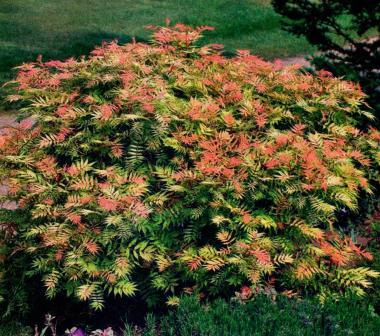
All these qualities, but in a much greater concentration, have the “Sam” variety that is gaining popularity among Russians. It is three times lower than the main species (maximum height 120-150 cm) and is more compact, gives fewer offspring, and its leaves are somewhat smaller. And most importantly, its young leaves are painted much brighter and more diverse than that of wild plants. It is the leaves, not flowers, that are Sam’s main decorative property. To describe them personally, epithets seem appropriate to me: openwork, carved, ornamental, colorful, bright. In their color spectrum there are not only yellow and orange tones, but also all shades of red - from light pink to magenta. 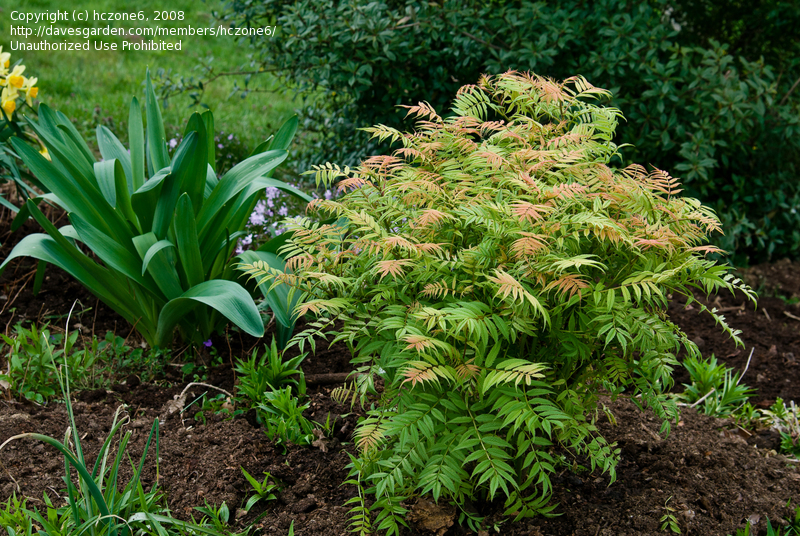
Blooms "Sam" as the main species at the end of June, but not large, and the size of its inflorescences, in comparison with the wild species, are small. So bloom often passes almost unnoticed. This, by the way, is more dignity than a disadvantage, because the flowering inflorescences of a species bush are no longer an ornament and require removal.
Especially valuable qualities are inherited "Sam" from the wild ancestor of frost resistance and unpretentiousness. It is undoubtedly interesting to both the ordinary amateur and professional landscapers, for whom it is so important not to lose face in front of the customer. "Sam" will not fail, will not lose its gloss at the most inopportune moment. Absolutely frost-resistant, “Sam” is very interesting for northerners. It should be noted that the leaves of “Sam” are not completely discolored, and although their brightness is slightly lost in June, it remains attractive.
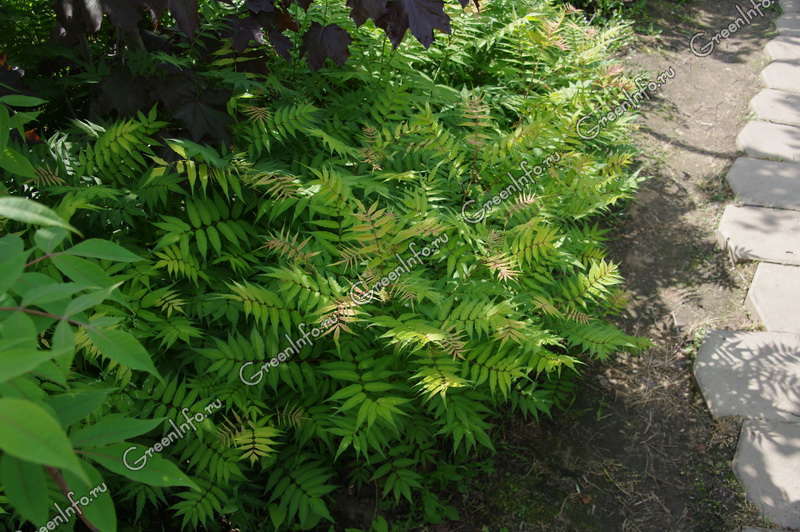
So that you know.
The genus of the grasshopper (Sorbaria), belonging to the Rosaceae family, has 10 shrub species found in Asia, including in the south of Siberia and the Far East. The ashberry ryabinnik (S. sorbifolia) except the south of Siberia, is found in China, Korea, and Japan. It grows as a medium-growth shrub about 2 m high (up to a maximum of 3 m) of a bush, with numerous straight, densely branching shoots. Leaves are single-pluminal, up to 25 cm long from 9-13 leaflets. By their addition, they resemble rowan, but only with a superficial glance. A shrub blossoms in June-July, small creamy-white flowers, collected in dense pyramidal panicles, up to 30 cm long, concentrated on the ends of the shoots. Flowering lasts about a month, in favorable conditions it is very abundant and impressive.Planting and care.
Like all Samov бин s foot soldiers, it is moisture-loving, and it is not demanding of fertility. It grows well both in the open sun and in various penumbra variants. At the same time, the shrub reaches the best decorative conditions on wet and drained, organic-rich soils. On the contrary, the combination of dryness and sterility of the soil, peculiar to thin suspensions, is the most unfortunate for the mountain man.
Location Open sun, slight or temporary partial shade.
The soil. Light or medium fertile loam of neutral or weakly acid reaction - pH = 6.5-7.0. A variation of the substrate can a mixture of sod land, humus and sand in an approximate ratio of 1: 1: 1 or 1: 2: 1.
When planting for shrubs dig holes shallow - enough 30-40 cm deep, but wide enough - up to 70-80 cm - taking into account its growth. When located on the slopes, tree trunks should be formed in the form of gentle funnels with a slope to the center of the bush, otherwise plants may suffer from a lack of moisture. Fieldfare well tolerated transplant. Shrub seedlings are well preserved when shipped by mail.
Care. The soil of the earthen coma of the shrub should be kept in a moderately humid state, and the base of the bush should be kept loose and free from weeds.
Fieldfare gratefully responds to the introduction of any kind of organic matter: humus, peat, compost. Digging of the trunk circle is not recommended, therefore fertilizers are shown to be applied superficially or under shallow embedding. The continuous thickets of the fieldfare force out the weeds, therefore weeding is necessary only at the beginning. Since the plant loves loose substrates, systematic mulching with peat, leaf humus and various types of composts is useful. It is advisable to perform the operation at least 2-3 times per season, in small doses, then the fertilizer will naturally assimilate. It is also recommended 1-2 times a year to sprinkle universal (NPK) mineral mixtures into the base of plants at a rate of no more than 20g / m 2.
Reproduction.The most simple rowfishes breed multiply bush or root suckers. Wild species can be easily propagated by seed. Green cutting is usually used for Sam and other varieties of mountain ash as the most productive and reliable method.

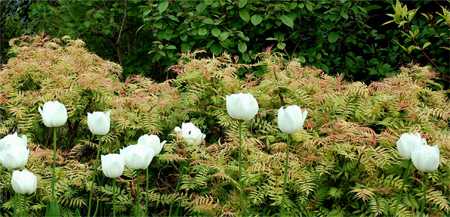
"Sam" in a private garden and in urban gardening.
On the one hand, the leaves of the fieldfare are reminiscent of the fronds of a fern, so the overgrown shrubs look very natural. On the other hand, it has almost a floral color. Because of this, “Sam” “eyes flare up”, both among those who love flower beds and those who support landscape style. The shrub is particularly attractive in that the peak of its ornamentalness comes at a time when the garden is just waking up from hibernation. At this time, the brightness, especially in the middle tier of gardening, is in absolute deficit. In addition to the decorative advantages, the Fieldfare is valuable because it is resistant to pests and diseases, and never loses its decorativeness.
A separate bush. Consider that the bush will grow over time and after 6-8 years it can “scatter” to the side by 70–80 cm. "Sam" looks good in mixed compositions based on contrasting combinations of color and shape. A single plant can be made the center of a small composition if you surround it with a carpet of perennial ground cover. In this capacity, suitable zhivuchki, lulznike monetchaty, kammelomki, mshanka, etc.
Group, array, curb. In essence, a group, that is, several Sam bushes planted next to each other can very soon turn into a solid array. Outwardly, it is very reminiscent of fern thickets. Both can be a wonderful element of yard gardening "in the highest category." Arrays of mountain ash are appropriate as a tamper at the foot of tree groups, and such flowering shrubs as lilac and chene.
Decorative leafy gardens. Compositions of plants, the main decoration of which are leaves, are good in that they do not require much labor and at the same time never lose their decorativeness. With such plots it is advisable to draw up the most important places of gardening. Next to "Sam" geyhery, hosts, thujas, junipers, badany look good ...
In all cases, the crown of an adult bush is advisable with a haircut to give a more compact form. Borders and arrays look very non-standard and interesting, their tops are trimmed at the knee height. It is enough to cut the bushes three times per season: the first time after the end of the first wave of growth - at the end of May, the second - in the middle of summer, and the last time at the end of September. 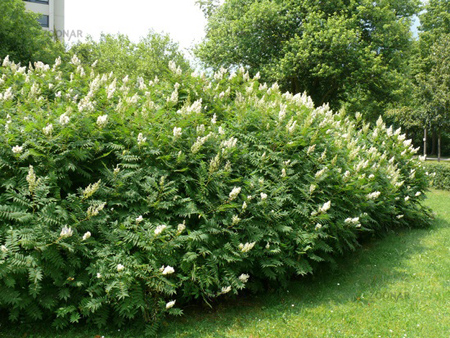
Fieldfare well tolerates the urban environment and is very desirable in all private and public landscaping. Owners of roadside food outlets, cafes, gas stations, motels interested in spectacular and low-cost landscaping will surely appreciate it. The use of fieldfirth is justified in the form of continuous thickets in those places that can be given to the shrub entirely, because they have natural barriers for its growth: islands of car lashes, windows in paving, etc. Its informal borders bordering on the edges of a group of tall shrubs and trees are unusually good.
For information:
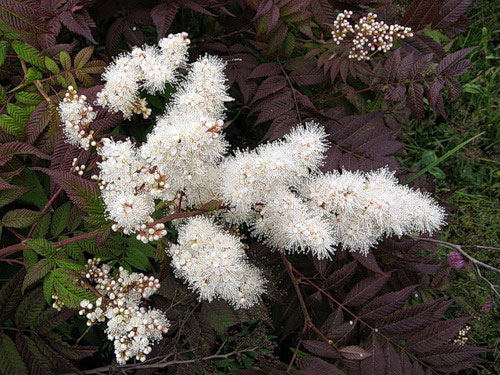 Feltman
Feltman
 Mountain ash tree
Mountain ash tree
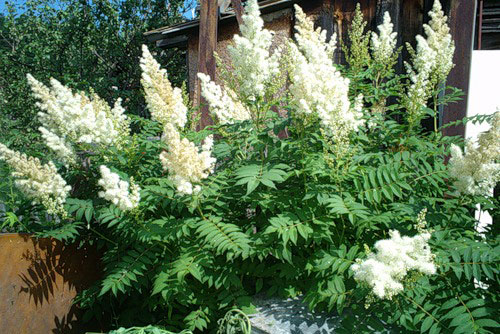 Pallas Fieldfare
Pallas Fieldfare
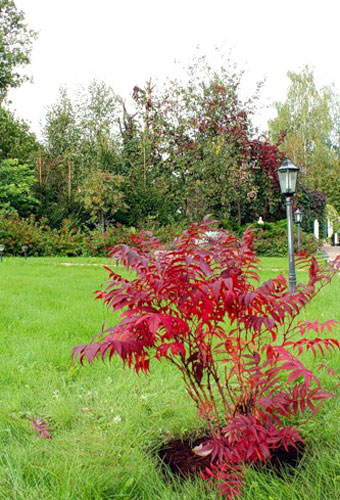 Rowanberry ryabinolistny
Rowanberry ryabinolistny

